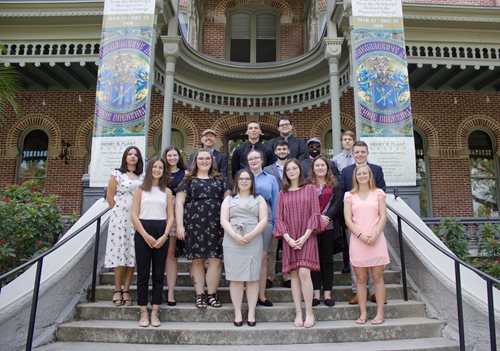Red Cross Nursing and the War of 1898: The Tampa Connection
This online exhibit is based on a 2018 panel exhibit of the same name created by history students at The University of Tampa and Dr. Charles McGraw Groh, Associate Professor of History.
Introduction
Many people know that Tampa and the Tampa Bay Hotel played an important role in the Spanish-Cuban-American War. Most remain unaware that the conflict witnessed the first time that the American Red Cross provided nursing services in wartime. This exhibit traces the path that led dozens of young women from New York to Tampa and Cuba in 1898.
La cruz roja
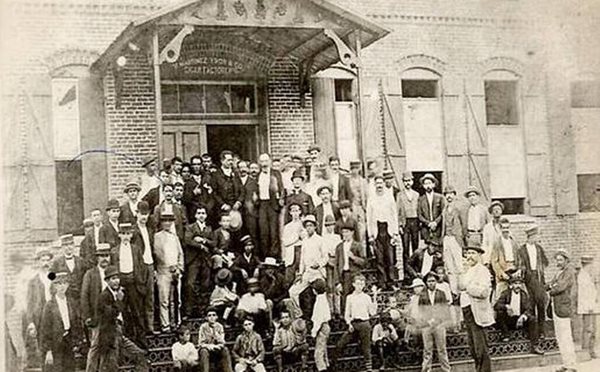
Photo of Jose Marti and cigar workers, courtesy of University of South Florida Special Collections.
The Cuban War of Independence (1895-1898) was the last of three conflicts waged by Cubans between 1868 and 1898 to achieve independence from Spain. Beginning in 1891, revolutionary leader José Marti made repeated trips to Florida to build support for the third war. He called Tampa’s cigar districts “the civilian camps of the revolution.”
Este Club tiene por objecto socorrer á nuestro ejército libertador, como también á las familias cubanas que se encontrasen en la desolación en esta ciudad.
The above quote is from José Acebal, Club Beneficio Público, Cruz Roja.
In January 1898, Patria, the newspaper of the Cuban Revolutionary Party, published a letter from the Club Beneficio Público. The Ybor City club was established as an unofficial auxiliary of the Red Cross with “the mission to help our liberating army, as well as the Cuban families who are in distress in this city.”
Every sister a nurse
Asked in early 1898 to distribute U.S. charitable donations in Cuba, Clara Barton looked to the New York Red Cross Hospital to provide medical assistance. Established in 1894, the small medical facility provided care to working-class immigrants, even as its nursing sisters trained to offer assistance in wars and natural disasters.
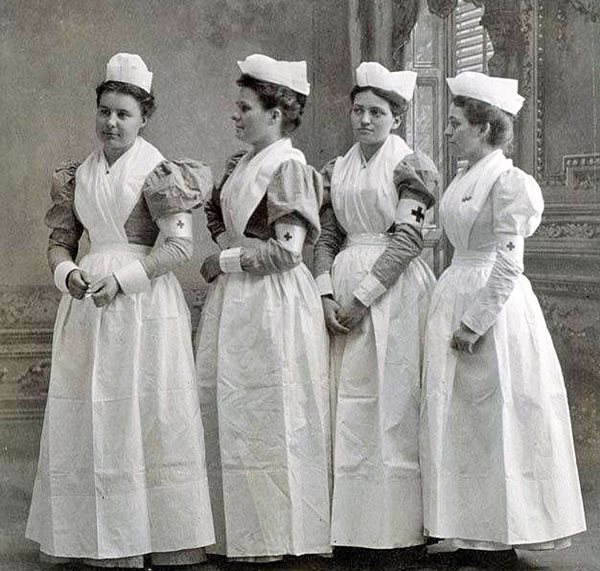
Sisters Isabelle, Annie, Blanche, and Minnie, from Clara Barton, The Red Cross (1898).
Sister Bettina Hofker Lesser (b.1872) immigrated to New York from Prussia in 1886. She completed a two-year program at the Mount Sinai Nurse Training School before opening the New York Red Cross Hospital, modeled after the German Red Cross. The hospital mandated that its nurses, called “sisters,” work without pay to demonstrate their selfless motives.
While every Sister must be a nurse, every nurse is not a Sister. Don’t take that pride from them if you can help it.
The above quote is from Dr. A. Monae Lesser, Surgeon-in-Chief, New York Red Cross Hospital.
The U.S. declaration of war against Spain in April 1898 led Sister Bettina to offer a short training course in battlefield nursing to graduates of other nurse training schools. The new American Red Cross recruits could not afford to serve without pay, creating the distinction between Red Cross Sisters and Nurses.
Clara barton
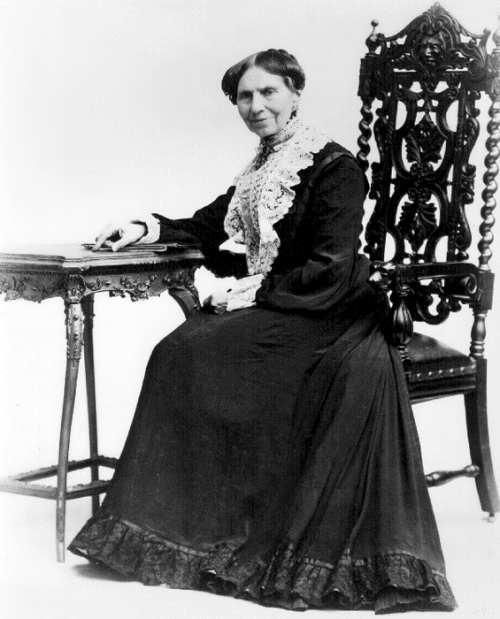
Clara Barton, courtesy of Library of Congress.
Clara Barton (1821-1912) was seventy-six years old when she arrived in Tampa to oversee the American Red Cross relief program in Cuba. Decades of humanitarian service in the U.S. Civil War, the Franco-Prussian War, and the Johnstown flood did not protect Barton from discrimination based on her gender and age.
Miss Barton is too old now for active work (for goodness sake, don't tell anyone I said that), but she is willing, conscientious, and painstaking.
The above quote is from Fitzhugh Lee, U.S. Counsul-General, Havana, 1898.
Sensitive to critical comments about her age, Barton became adept at using cosmetics to appear more youthful. Her fondness for green dresses and red ribbon accessories over more staid garments still led critics, including Christian Herald editor Louis Klopsch, to make unkind remarks.
.png.aspx;)
cuban relief
Between 1896 and 1898, more than a quarter of the Cuban population died from starvation, poor sanitary conditions, and inadequate medical treatment under the Spanish policy of “reconcentration.” Civilians were herded into urban centers with military guards in an unsuccessful attempt to undermine the Cuban revolutionaries’ base of support.
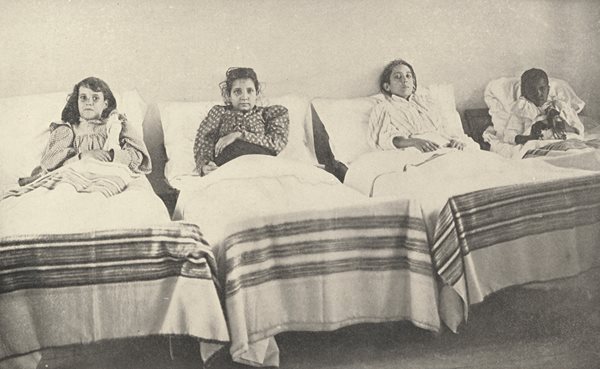
Photograph from Barton, The Red Cross (1898).
In February 1898, Sister Bettina Hofker Lesser worked with local caregivers to establish an orphanage and clinic in Havana. Soon, Sister Blanche McCorristen took charge of the facility, while Sisters Minnie Rogal, Isabelle Olm, and Annie McCue assisted Lesser in converting a municipal shelter into a Red Cross Hospital.
Todos han sido atendidos con el mayor de los cuidados … por la buena e inteligente Sra. Lesser, quien es el ángel de la consolación.
The above quote is from twenty-one Cuban physicians.
Unlike the U.S. military intervention, American Red Cross aid was universally welcomed by Cubans. On March 25, 1898, twenty-one Cuban physicians gave thanks for the orphanage and hospital, where “all are attended with the greatest care … by the good and intelligent Mrs. Lesser, who is the angel of consolation.”
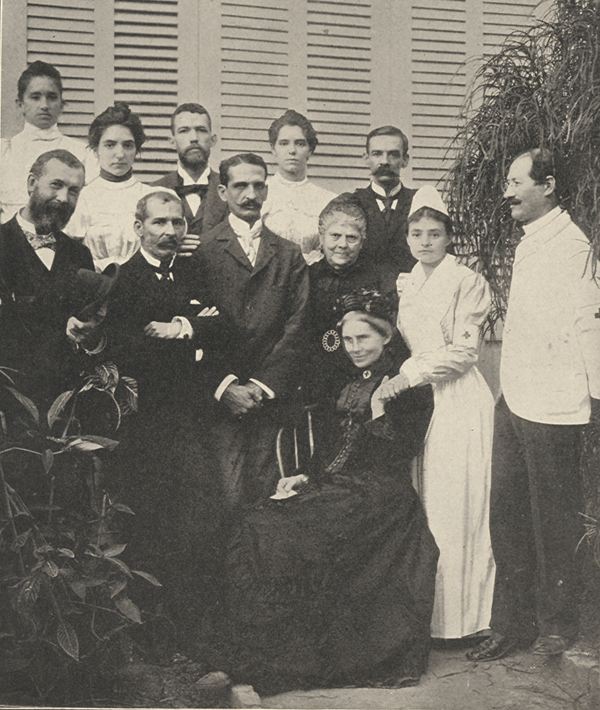
Photograph from Barton, The Red Cross (1898).
Columbia's Task
After touring the Red Cross orphanage in Havana, Senator Redfield Proctor praised the work of Sister Bettina in a congressional address on March 17, 1898. Newspaper editors who advocated war seized upon the image of the Red Cross Sister as a symbol of the supposedly selfless motives of the United States.
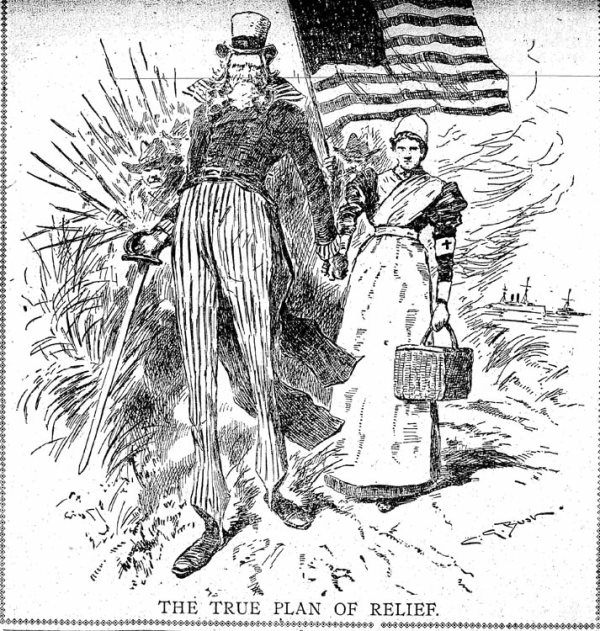
Cartoon from Joseph Pulitzer’s New York World, April 30, 1898.
In the cartoon that follows,
Life magazine dressed Columbia in a Red Cross uniform to distinguish U.S. motives from the typical behavior of imperial nations. Despite such depictions, the war with Spain allowed the United States to acquire a formal overseas empire, which came to include Puerto Rico, the Philippines, Guam, and Hawaii.
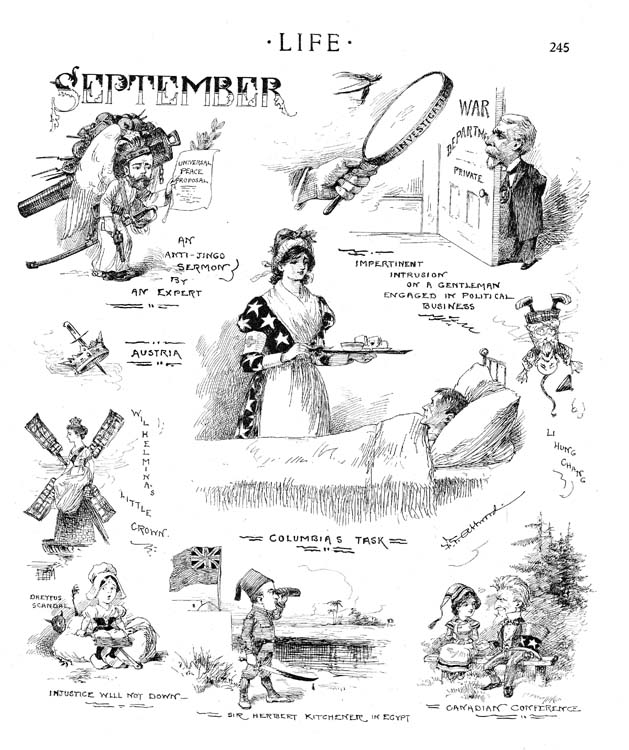
Cartoon from Life, September 29, 1898.
Red Cross in Tampa
.bmp.aspx;?width=600&height=610) Newspaper Cutting, Clara Barton Papers, Library of Congress.
Newspaper Cutting, Clara Barton Papers, Library of Congress.
After the Red Cross evacuated Havana in April, Sister Bettina traveled to New York to recruit additional nurses. Her four Red Cross sisters stayed in Tampa. The women staged a field exercise in Hyde Park, showing locals how to apply bandages and splints. All five sisters left Tampa on June 20, 1898 to return with Clara Barton to Cuba.
Yet close at hand [to the typhoid patients on Picnic Island] was the Inn Port Tampa, and only a few miles away was the palatial Tampa Bay Hotel where not only the necessities but most of the luxuries of life could be had for the asking.
The above quote is from Beatrice Von Homrigh, Red Cross Nurse.
The first group of supplemental Red Cross nurses reached Tampa on July 4, finding accommodations at Henry Plant’s Port Tampa Inn. At the request of army physicians, they hitched up their dresses in torrential rain to reach Picnic Island on foot, where they treated soldiers suffering from typhoid.
.JPG.aspx;?width=600&height=807) Map from Henry B. Plant Museum collection.
Map from Henry B. Plant Museum collection.
The Tampa Bay Hotel
As camp with 20,000 men [was] opposite the Hotel, she said we would be chaperoned, both going about, also in dining room, and nobody would be allowed out after dark.
The above quote is from Catherine D. Pilgard, Red Cross Nurse.
Nurses spent at least one night at the Tampa Bay Hotel in July 1898. American Red Cross organizers worried that the professional women had developed an “independence of ordinary social requirements” that might be misinterpreted by military officials and Tampa residents, so their behavior was closely monitored in the mixed-sex spaces of the hotel.
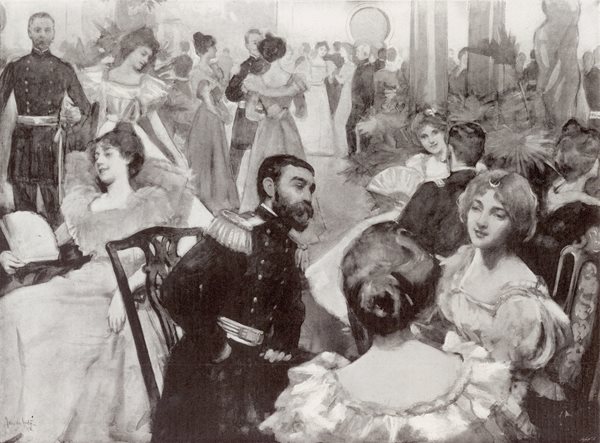 Illustration courtesy of Henry Plant Museum Archives, Gift of Robin Robson Gonzalez.
Illustration courtesy of Henry Plant Museum Archives, Gift of Robin Robson Gonzalez.
.png.aspx;)
war in cuba
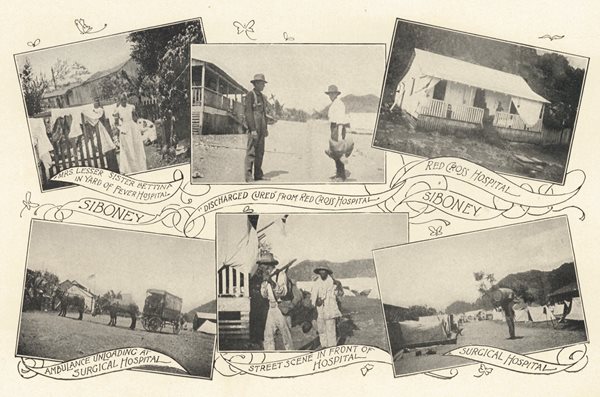 Image from Barton, The Red Cross (1898)
Image from Barton, The Red Cross (1898)
Sister Bettina and her four Red Cross sisters returned to Cuba on June 26, 1898. Following General William Shafter’s assault on El Caney and San Juan, the nurses assisted U.S. military surgeons at the hastily-constructed First Division Hospital. The sisters also took charge of a hospital for General Calixto Garciá’s Cuban forces and a separate facility for fever patients.
In 24 hours … four Red Cross sisters—trained nurses—assisted the surgeons, working the entire time without rest, other than a moment to take a cup of coffee.
The above quote is from Janet Jennings, war correspondent.
Of the five trained nurses who served in Cuba, all but one, Sister Annie McCue, contracted yellow fever. They survived, but Sister Bettina struggled with health issues for years after the war. In 1900, the U.S. Army established the Reed Commission, which finally confirmed that mosquito bites transmitted the deadly disease.
dear mrs. edison
One nursing duty continued for years after the War of 1898, the task of writing condolence letters to the families of fallen soldiers. Long after Pvt. Theodore Miller was fatally wounded in the Battle of San Juan Hill, Bettina Hofker Lesser offered words of comfort to his sister Mina, the wife of inventor Thomas Edison.
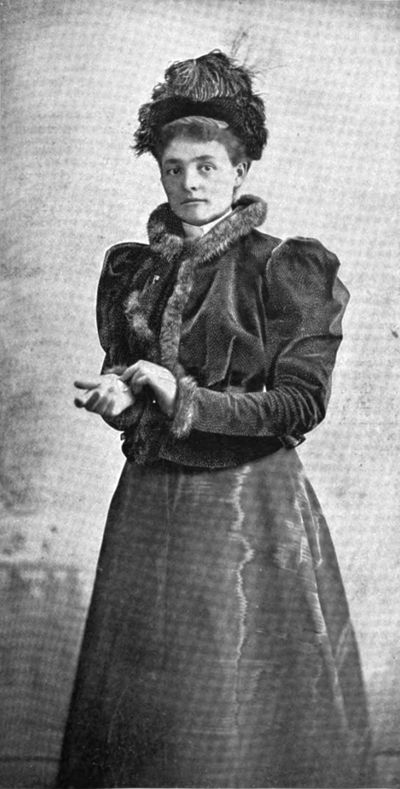 Bettina Hofker Lesser, The Puritan 4:1 (October 1898), p. 7.
Bettina Hofker Lesser, The Puritan 4:1 (October 1898), p. 7.
Lesser assured Mrs. Edison that the young soldier was cared for “with the same spirit as a mother would care for a child.” The nurse promised that his last hours were “peaceful and contented” and filled with memories of “his happy home life.”
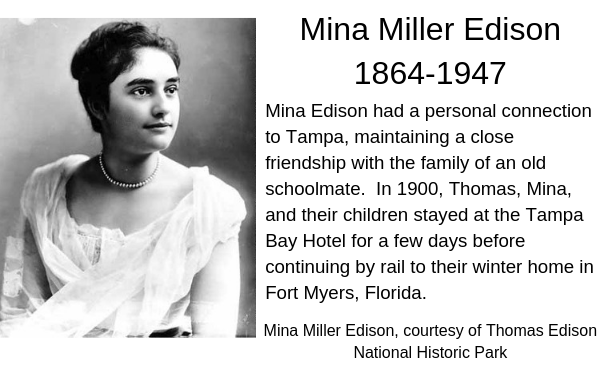
Further Reading
Nancy A. Hewitt, Southern Discomfort: Women’s Activism in Tampa, Florida, 1880s-1920s (Urbana: Univ. of Illinois Press, 2001).
Charles McGraw, "'The Intervention of a Friendly Power': The Transnational Migration of Women’s Work and 1898 Imperial Imagination,” Journal of Women’s History 19:3 (Fall 2007), 137-160.
Louis A. Pérez Jr., "Cubans in Tampa: From Exiles to Immigrants," Florida Historical Quarterly 57:2 (1978), 129-40.
Elizabeth Brown Pryor, Clara Barton: Professional Angel (Philadelphia: Univ. of Pennsylvania Press, 1987).
This exhibit was researched by Dr. Charles McGraw Groh and curated by the following University of Tampa students:
Kevin Cadigan, Ryan DePietro, Sarah Doolittle, Bryan Hammons, Marcus Hayes, Ross Manning, Selena Martinez, Emera Maupin, Lindsay Nathanson, Christopher Pirrie, Nicole Sandoval, Erin Seaman, Kaitlyn Stockdale, Camerin Walker, and Erin Whitson.
